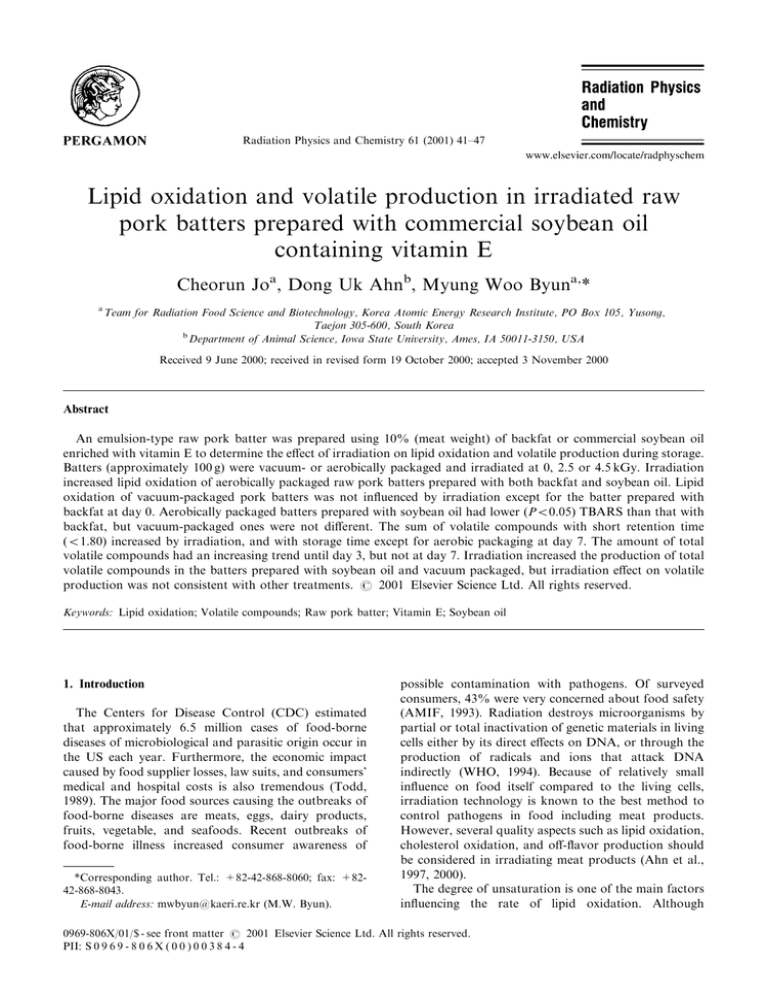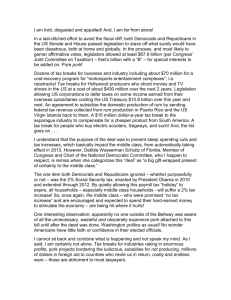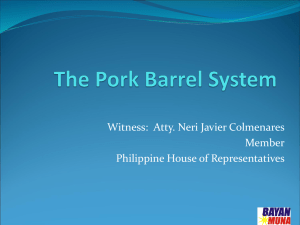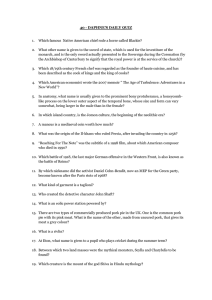
Radiation Physics and Chemistry 61 (2001) 41–47
Lipid oxidation and volatile production in irradiated raw
pork batters prepared with commercial soybean oil
containing vitamin E
Cheorun Joa, Dong Uk Ahnb, Myung Woo Byuna,*
a
Team for Radiation Food Science and Biotechnology, Korea Atomic Energy Research Institute, PO Box 105, Yusong,
Taejon 305-600, South Korea
b
Department of Animal Science, Iowa State University, Ames, IA 50011-3150, USA
Received 9 June 2000; received in revised form 19 October 2000; accepted 3 November 2000
Abstract
An emulsion-type raw pork batter was prepared using 10% (meat weight) of backfat or commercial soybean oil
enriched with vitamin E to determine the effect of irradiation on lipid oxidation and volatile production during storage.
Batters (approximately 100 g) were vacuum- or aerobically packaged and irradiated at 0, 2.5 or 4.5 kGy. Irradiation
increased lipid oxidation of aerobically packaged raw pork batters prepared with both backfat and soybean oil. Lipid
oxidation of vacuum-packaged pork batters was not influenced by irradiation except for the batter prepared with
backfat at day 0. Aerobically packaged batters prepared with soybean oil had lower (P50.05) TBARS than that with
backfat, but vacuum-packaged ones were not different. The sum of volatile compounds with short retention time
(51.80) increased by irradiation, and with storage time except for aerobic packaging at day 7. The amount of total
volatile compounds had an increasing trend until day 3, but not at day 7. Irradiation increased the production of total
volatile compounds in the batters prepared with soybean oil and vacuum packaged, but irradiation effect on volatile
production was not consistent with other treatments. # 2001 Elsevier Science Ltd. All rights reserved.
Keywords: Lipid oxidation; Volatile compounds; Raw pork batter; Vitamin E; Soybean oil
1. Introduction
The Centers for Disease Control (CDC) estimated
that approximately 6.5 million cases of food-borne
diseases of microbiological and parasitic origin occur in
the US each year. Furthermore, the economic impact
caused by food supplier losses, law suits, and consumers’
medical and hospital costs is also tremendous (Todd,
1989). The major food sources causing the outbreaks of
food-borne diseases are meats, eggs, dairy products,
fruits, vegetable, and seafoods. Recent outbreaks of
food-borne illness increased consumer awareness of
*Corresponding author. Tel.: +82-42-868-8060; fax: +8242-868-8043.
E-mail address: mwbyun@kaeri.re.kr (M.W. Byun).
possible contamination with pathogens. Of surveyed
consumers, 43% were very concerned about food safety
(AMIF, 1993). Radiation destroys microorganisms by
partial or total inactivation of genetic materials in living
cells either by its direct effects on DNA, or through the
production of radicals and ions that attack DNA
indirectly (WHO, 1994). Because of relatively small
influence on food itself compared to the living cells,
irradiation technology is known to the best method to
control pathogens in food including meat products.
However, several quality aspects such as lipid oxidation,
cholesterol oxidation, and off-flavor production should
be considered in irradiating meat products (Ahn et al.,
1997, 2000).
The degree of unsaturation is one of the main factors
influencing the rate of lipid oxidation. Although
0969-806X/01/$ - see front matter # 2001 Elsevier Science Ltd. All rights reserved.
PII: S 0 9 6 9 - 8 0 6 X ( 0 0 ) 0 0 3 8 4 - 4
42
C. Jo et al. / Radiation Physics and Chemistry 61 (2001) 41–47
linolenic acid is a minor component in soybean oil, it
has a deleterious effect on the oxidative stability and
flavor of soybean oils (Liu and White, 1992). Irradiation
at 10 and 15 kGy resulted in loss of phopholipids in
rice bran and increased the amount of free fatty
acids (Shin and Godbler, 1996). The oxidation of
lipids in raw meat is closely related to the antioxidant
potential of muscle tissues. Vitamin E is a major
antioxidants in cell membranes and protects the
membrane lipids and cholesterol from peroxidative
damages caused by reactive free radicals (Buckley
et al., 1995; Liu et al., 1995). Dietary dl-a-tocopheryl
acetate more than 200 IU/kg decreased lipid oxidation
and reduced total volatiles of raw turkey patties after 7
days of storage (Ahn et al., 1997). Lee et al. (1999) found
that ascorbyl palmitate significantly reduced oxidation
of irradiated oils and its effect was concentrationdependent.
At present, many meat processors started to test
market irradiated raw ground meat products. Furthermore, meat industry is petitioning for the approval of
irradiation on processed meat. However, the relationship between fatty acid composition, use of antioxidant,
and the production of volatiles in irradiated processed
meat is not clearly known. The objective of present
study was to determine the effect of vitamin E enriched
soybean oil on lipid oxidation and volatile production in
irradiated raw pork batters with different packaging
conditions.
2. Materials and methods
2.1. Sample preparation
Lean pork and pork backfat were purchased from a
local packing plant and ground twice through a 9-mm
plate. An emulsion-type pork product was prepared
using ground meat, NaCl (2% of meat weight), ice water
(10% of meat weight), and pork backfat (10% of meat
weight). Soybean oil (Preferred Products, Inc., Eden
Prairie, MN 55334) was purchased from a local market
and added instead of pork backfat as a treatment.
Batters (approximately 100 g each) were vacuum packaged in oxygen-impermeable nylon/polyethylene bags
(9.3 ml O2/m2/24 h at 08C, Koch, Kansas City, MO) and
stored overnight at 48C to minimize changes before
irradiation. The next morning, half of the vacuumpackaged bags were cut open to make aerobic conditions, and meat batters were irradiated at 0, 2.5, or
4.5 kGy (average absorbed dose; dose rate was 107 kGy/
min) using a linear accelerator (Circe IIIR, Thomson
CSF Linac, France). The other half was irradiated in
vacuum state. To confirm the target dose, two alanine
dosimeters per cart were attached to the top and bottom
surfaces of the sample. The samples were analyzed 3 h
after irradiation.
2.2. Lipid oxidation, fat content, and fatty acid
composition
Lipid oxidation was determined as a 2-thiobarbituric
acid reactive substances (TBARS) value by using a
spectrophotometer (DU series 600, Beckman Instruments, Inc., Fullerton, CA) as described by Ahn et al.
(1997). TBARS values were expressed by mg malondialdehyde (MDA) per kg meat. Total fat content was
determined by Folch’s extraction method (Folch et al.,
1957). Fatty acid methylation was performed with BF3methanol (14% solution, Supelco, Bellefonte, PA). The
fatty acid methyl esters were separated on a HewlettPackard Gas Chromatograph (GC, Model 6890, Hewlett-Packard Co., Wilmington, DE) equipped with a
flame ionization detector. A split inlet (split ratio, 29:1)
was used to inject samples into a HP-5 capillary column
(0.25 mm 30 m 0.25 mm), and ramped oven temperature was used (808C for 0.3 min, increased to 1808C,
308C/min, and increased to 2308C, 68C/min). Inlet and
detector temperature were 180 and 2808C, respectively.
Helium was the carrier gas at constant flow of 1.1 ml/
min. Detector air, H2, and make-up gas (He) flows were
300, 30, and 28 ml/min, respectively.
2.3. Vitamin E analysis
Raw pork batter (2 g) was homogenized in 10 ml
(wt/vol) of phosphate-EDTA buffer (pH 7.0). The
amounts of a- and g-tocopherol were determined using
high-performance liquid chromatography (HPLC, Shimadzu Co., Kyoto, Japan) as described by Ahn et al.
(1995).
2.4. Volatile compounds analysis
Precept II and Purge-and-Trap concentrator 3000
(Tekmar-Dohrmann, Cincinnati, OH) were used to
purge and trap volatile compounds, and a GC (Hewlett-Packard, Model 6890, Wilmington, DE) equipped
with a flame ionization detector (FID) was used to
analyze volatile compounds from meat batters. Meat
batter (3 g) was sampled and analyzed using the
conditions described by Ahn et al. (1997).
2.5. Statistical analysis
One-way analyses of variance (ANOVA) was used to
determine the effect of added fat sources on major fatty
acids, fat content, and vitamin E content by SAS
software (SAS, 1989). Two-way ANOVA was performed to determine the effect of irradiation dose and
fat source on the TBARS value and the production of
43
C. Jo et al. / Radiation Physics and Chemistry 61 (2001) 41–47
volatile compounds. Tukey’s multiple range test was
used to compare differences among means (Steel and
Torrie, 1980). Means and their pooled standard errors
(SEM) were reported.
3. Results and discussion
3.1. Fatty acid composition, fat content, vitamin E
content
The raw pork batter with commercial soybean oil had
significantly higher linoleic acid (C18:2) than that with
backfat (Table 1). Reported oleic acid contents in lard
and soybean oil were generally 44 and 24%, respectively
(ISEO, 1994). The results showed that the batter
prepared from backfat had similar amount of oleic acid
percentage but the batter prepared from soybean oil had
32.46%, which was higher than oil (Table 1). Linoleic
acid contents were 10 and 54% in lard and soybean oil,
respectively, which had higher percentage than the
present results of the batter. It is possibly due to the
saturation during making the batters. Fat content of the
raw pork batter with backfat (11.51%) was lower than
that with soybean oil (12.80%, P50.05) because of the
other substances such as water in the backfat. The
a- and g-tocopherol content of the commercial soybean
oil were 99.8 and 691.1 ppm, respectively. Jo and Ahn
(2000) reported that the amount of gamma tocopherol in
sausage prepared with flaxseed oil containing vitamin E
was 100- to 200-fold higher than that prepared with
lard or corn oil. Similarly, the raw pork batter
prepared with commercial soybean oil had about 35
times higher a-tocopherol contents and about 200 times
higher g-tocopherol content than that prepared with
backfat when cooked because of added amount of
vitamin E into the commercial products (data are not
shown).
3.2. Lipid oxidation
Irradiation at 4.5 kGy dose increased the TBARS
value of aerobically packaged raw pork batter prepared
with both fat sources except for the batter with soybean
oil at day 7 (Figs. 1A and B). Katusin-Razem et al.
(1992) reported that irradiation-induced oxidative
changes were dose-dependent, and the presence of
oxygen had a significant effect on the rate of oxidation.
Aerobic packaging also increased the lipid oxidation of
raw pork batter during the 7-day storage regardless of
fat sources used. Statistical analysis indicated that the
TBARS of raw pork batter were affected by fat source in
aerobic packaging (P50.05). Theoretically, the raw
pork batter with soybean oil should have higher lipid
oxidation rate because of higher linoleic acid content,
but had lower TBARS at days 3 and 7 (P50.05). Galvin
et al. (1998) reported that high vitamin E content in
muscle via the dietary supplementation reduced lipid
and cholesterol oxidation in chicken muscle. Jo and Ahn
(2000) also reported that vitamin E contained in the
flaxseed oil helped to maintain low TBARS of cooked
pork sausages during storage even though the sausage
prepared with flaxseed oil had higher amount of
linolenic acid. With vacuum packaging, the TBARS of
raw pork batter prepared with backfat increased only at
day 0 by irradiation (Fig. 1C), but that of the other
treatment combinations (irradiation fat sources) was
not changed. The TBARS of vacuum-packaged raw
pork batter prepared with soybean oil did not change
either by irradiation or by storage (Fig. 1D). Therefore,
the results indicated that lipid oxidation did not develop
without oxygen.
3.3. Volatile compounds analysis
The sum of volatile compounds coming out before
1.80 min of retention time increased by irradiation and
also by storage (Fig. 2). Three to eight volatile
compounds were detected but they could not be
separated by present method used. With aerobic
packaging, the raw pork batter prepared with soybean
oil produced smaller amounts of volatiles coming out at
early stage of volatile analysis than those with the
backfat (Figs. 2A and B). The pork batter prepared with
soybean oil contained higher amount of polyunsaturated fatty acids than the backfat, high vitamin E
Table 1
Major fatty acids (%) of raw pork batter prepared with pork backfat or commercial soybean oil containing vitamin Ea
Fat used
C14:0
C16:0
C16:1
C18:0
C18:1
C18:2
Backfat
Soybean oil
SEMb
0.07
0.01
0.033
22.96a
13.76b
0.564
0.31
0.19
0.090
25.16a
8.36b
0.366
47.07a
32.46b
1.154
5.42b
45.26a
0.779
a
b
Means with different letters within a column are significantly different (P50.05), n=6.
SEM: Pooled standard errors of the mean.
44
C. Jo et al. / Radiation Physics and Chemistry 61 (2001) 41–47
Fig. 1. TBARS values (mg malondialdehyde/kg meat) of irradiated raw pork batter: (A) prepared with backfat and aerobically
packaged, (B) prepared with commercial vitamin E added soybean oil and aerobically packaged, (C) prepared from backfat and
vacuum-packaged, (D) prepared with commercial vitamin E added soybean oil and vacuum-packaged. Different letters (a,b) within the
same storage day are significantly different (P50:05), Different letters (x–z) within the same irradiation dose are significantly different
(P50.05).
content in the product should have slowed the development of lipid oxidation in that sample. Irradiation
increased the amount of volatile compounds eluting at
early stage of analysis (retention time51.8 min) regardless of fat sources or packaging method. The amount of
volatile compounds with very short retention time
(51.80) was smaller in vacuum packaged than in
aerobically packaged samples (P50:05), but was not
influenced by oil used. Jo et al. (1999) also reported
many unknown volatile compounds with short
retention time in irradiated cooked sausages. They
suggested that those compounds would be non-polar
small hydrocarbons and could be important for
irradiation odor. Further investigation for the
identification of these volatile compounds and relation-
ship of these compounds with irradiation off-flavor is
needed.
The amount of total volatile compounds was rather
complicated. With aerobic packaging, the total amount
of volatile compounds in raw pork batter prepared with
backfat increased by irradiation at day 0, but the
difference in total volatile content between irradiated
and non-irradiated pork batters disappeared after 3 days
of storage (Fig. 3A). The amount of total volatile in raw
pork batters prepared with soybean oil and irradiated at
0 and 2.5 kGy increased during storage, but that of the
4.5 kGy did not probably because of the large sample-tosample variations (Fig. 3B). Irradiation had no effect on
the amount of total volatile of vacuum-packaged pork
batters prepared with soybean oil. Raw pork batter
C. Jo et al. / Radiation Physics and Chemistry 61 (2001) 41–47
45
Fig. 2. Amount of volatile compounds with short retention time (51.80) from raw pork batter prepared with pork backfat or
commercial soybean oil containing vitamin E: (A) prepared with backfat and aerobically packaged, (B) prepared with commercial
vitamin E added soybean oil and aerobically packaged, (C) prepared with backfat and vacuum-packaged, (D) prepared with
commercial vitamin E added soybean oil and vacuum-packaged. Different letters (a–c) within the same storage day are significantly
different (P50:05), Different letters (x–z) within the same irradiation dose are significantly different (P50:05).
prepared with soybean oil produced lower amount of
total volatile than the backfat at day 0 (P50:05), but no
difference was found at days 3 and 7. The amounts of
total volatiles in vacuum-packaged raw pork batters
increased by storage except for the samples irradiated at
4.5 kGy (Figs. 3C and D). The pork batter prepared
with soybean oil produced lower amount of total
volatiles than the backfat. The trend in the production
of total volatiles did not agree well with the TBARS
values (Figs. 1 and 3). The amounts of total volatile
compounds were not different, but lipid oxidation was
lower in vacuum-packaged raw pork batter than the
aerobic-packaged. One of the reasons could be headspace oxygen in sample vial, which could have reacted
with the sample and produced more volatile compounds
during sample holding and analysis. Ahn et al. (1999)
reported that helium flush or helium flush combined
with oxygen absorber were useful in eliminating residual
oxygen and minimized oxidative changes in meat during
sample holding time. Among individual volatile compounds, the production of 2-methylpropanal, 2-methylbutanal, and penatal had similar trends to the amount
of total volatile (P50:05, data are not shown).
Isopropanal, pentanal, sec-butanol, and 1-dodecanone
were also detected from the method used, but the
results were inconsistent. Hexanal, known as an
indicator of lipid oxidation and meat flavor deterioration (Shahidi and Pegg, 1994), was not found from
the raw pork batter prepared either backfat or soybean
oil. Considering minimal TBARS and no hexanal
46
C. Jo et al. / Radiation Physics and Chemistry 61 (2001) 41–47
Fig. 3. Amount of total volatile compounds from raw pork batter prepared with pork backfat or soybean oil containing vitamin E: (A)
prepared with backfat and aerobically packaged, (B) prepared with commercial vitamin E added soybean oil and aerobically packaged,
(C) prepared from backfat and vacuum-packaged, (D) prepared with commercial vitamin E added soybean oil and vacuum-packaged.
Different letters (a–c) within the same storage day are significantly different (P50:05), Different letters (x–z) within the same
irradiation dose are significantly different (P50:05).
production in both raw pork batters prepared with
backfat and soybean oil suggested that lipid oxidation
was not the major cause of quality deterioration in
irradiated pork batters.
Acknowledgements
This research is partially supported by Korea
Ministry of Science and Technology.
References
Ahn, D.U., Jo, C., Olson, D.G., 1999. Headspace oxygen in
sample vials affects volatiles production of meat during the
automated purge-and-trap/GC analyses. J. Agric. Food
Chem. 47, 2776–2781.
Ahn, D.U., Jo, C., Olson, D.G., 2000. Analysis of volatile
components and the sensory characteristics of irradiated raw
pork. Meat Sci. 54, 209–215.
Ahn, D.U., Kawamoto, C., Wolfe, F.H., Sim, J.S., 1995.
Dietary alpha-linolenic acid and mixed tocopherols, and
packaging influence lipid stability in broiler chicken breast
and leg muscle tissue. J. Food Sci. 60, 1013–1018.
Ahn, D.U., Sell, J.L., Jeffery, M., Jo, C., Chen, X., Wu, C.,
Lee, J.I., 1997. Dietary vitamin E affects lipid oxidation and
total volatiles of irradiated raw turkey meat. J. Food Sci. 62,
954–958.
AMIF., 1993. A Study of Consumers’ Awareness, Knowledge
and Attitudes Towards the Process of Irradiation. Amer.
Meat Inst. Found., Arlington, VA.
Buckley, D.J., Morrissey, P.A., Gray, J.I., 1995. Influences of
dietary vitamin E on the oxidative stability and quality of pig
meat. J. Anim. Sci. 73, 3122–3130.
C. Jo et al. / Radiation Physics and Chemistry 61 (2001) 41–47
Folch, J., Less, M., Sloane-Stanely, G.M., 1957. A simple
method for the isolation and purification of total lipids from
animal tissues. J. Biol. Chem. 226, 497–505.
Galvin, K., Morrisssey, P.A., Buckley, D.J., 1998. Cholesterol
oxides in processed chicken muscle as influenced by dietary
a-tocopherol supplementation. Meat Sci. 48, 1–9.
ISEO., 1994. Food Fats and Oils. Institute of Shortening and
Edible Oils Inc., Washington, DC.
Jo, C., Ahn, D.U., 2000. Volatile compounds production and
oxidative changes in irradiated pork sausage with different
fatty acids and tocopherol content. J. Food Sci. 65, 270–275.
Jo, C., Lee, J.I., Ahn, D.U., 1999. Lipid oxidation, color
changes and volatiles production in irradiated pork sausage
with different fat content and packaging during storage.
Meat Sci. 51, 355–361.
Katusin-Razem, B., Mihaljevic, K.W., Razem, D., 1992. Timedependent post irradiation oxidative chemical changes in
dehydrated egg products. J. Agric. Food Chem. 40, 1948–1952.
Lee, K.H., Yook, H.S., Lee, J.W., Park, W.J., Kim, K.S.,
Byun, M.W., 1999. Quenching mechanism and kinetics of
ascorbyl palmitate for the reduction of the gamma irradiation-induced oxidation of oils. JAOCS 76, 921–925.
47
Liu, Q., Lanari, M.C., Schaefer, D.M., 1995. A review of
dietary vitamin E supplementation for improvement of beef
quality. J. Anim. Sci. 73, 3131–3140.
Liu, H.R., White, P.J., 1992. Oxidative stability of soybean oils
with altered fatty acid compositions. JAOCS 69, 528–532.
SAS Institute, Inc., 1989. SAS User’s Guide1. SAS Institute
Inc. Cary, NC.
Shahidi, F., Pegg, R.B., 1994. Hexanal as an indicator of the
flavor deterioration of meat and meat products. Am. Chem.
Soc. Symp. Ser. 558, 256–279.
Shin, T.S., Godbler, J.S., 1996. Changes of endogeneous
antioxidants and fatty acid composition in irradiated rice
bran during storage. J. Agric. Food Chem. 44, 567–573.
Steel, R.G.D., Torrie, J.H., 1980. Principle and Procedures of
Statistics; A Biomedical Approach, 2nd Edition. McGrawHill Book Company. New York, pp. 185–186.
Todd, E.C.D., 1989. Preliminary estimates of costs of
foodborne disease in the United States. J. Food Prot. 52,
595–601.
WHO., 1994. Food irradiation. Safety and Nutritional Adequacy of Irradiated Food. World Health Organization,
Geneva, pp. 5–13 (Chapter 2).






